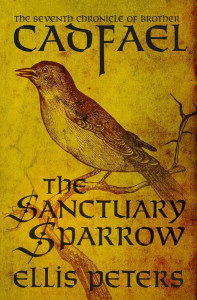A Morbid Taste For Bones (Warner, 1977)
One Corpse Too Many (Warner, 1979)
Monk’s Hood (Warner, 1980)
St. Peters Fair (Warner, 1981)
The Leper of St. Giles (Warner, 1981)
The Virgin in the Ice (Warner, 1982)
The Sanctuary Sparrow (Warner, 1983)
The Devil’s Novice (Warner, 1983)
Dead Man’s Ransom (Warner, 1984)
The Pilgrim of Hate (Warner, 1984)
An Excellent Mystery (Warner, 1985)
The Raven in the Foregate (Warner, 1986)
The Rose Rent (Warner, 1986)
The Hermit of Eyton Forest (Warner, 1987)
The Confession of Brother Haluin (Warner, 1988)
A Rare Benedictine (Warner, 1988)
The Heretic’s Apprentice (Warner, 1989)
The Potter’s Field (Warner, 1989)
The Summer of the Danes (Warner, 1991)
The Holy Thief (Warner, 1992)
Brother Cadfael’s Penance (Warner, 1994)
 The Chronicles of Brother Cadfael begin in 1137 with a trip to Gwytherin to secure a saint’s bones, and end in 1145 with a trip to Coventry to ransom an imprisoned knight. The years between are filled with crimes of passion, romances, murders, friendships made and faith affirmed — and the grounds of Shrewsbury Abbey and the monastery of Saints Peter and Paul made a far, far better place. Sounds like a tall order, and indeed it is, but for Ellis Peters and Brother Cadfael it is all in a day’s work.
The Chronicles of Brother Cadfael begin in 1137 with a trip to Gwytherin to secure a saint’s bones, and end in 1145 with a trip to Coventry to ransom an imprisoned knight. The years between are filled with crimes of passion, romances, murders, friendships made and faith affirmed — and the grounds of Shrewsbury Abbey and the monastery of Saints Peter and Paul made a far, far better place. Sounds like a tall order, and indeed it is, but for Ellis Peters and Brother Cadfael it is all in a day’s work.
Brother Cadfael is a monk of the Benedictine order, a former Crusader who came to his calling late in life after many years as a man-at-arms in the Holy Land. As Peters says in the introduction to A Rare Benedictine, “Brother Cadfael sprang to life suddenly and unexpectedly when he was already approaching sixty, mature, experienced, fully armed and seventeen years tonsured.” First introduced in A Morbid Taste for Bones, Cadfael is an herbalist and healer with a wide knowledge of his craft and a much more comprehensive understanding of the world than many of the long cloistered brothers of his Order.
The Cadfael books are truly an incredible read. Ellis Peters (real name Edith Pargeter) lived in Shropshire, not far from the real Shrewsbury Abbey, and she knew her setting in intimate detail. She was also a painstakingly accurate researcher, and her historical references are nearly flawless. I’m sure that there may be small errors, but I think it would require at least a master’s degree in history to catch them … and if you’re that obsessed, you might consider reading some self-help books before you attack fiction.
The specific time period in which the Cadfael books take place was a turbulent time in English history. The Empress Maud and her cousin Stephen were fighting for the throne, and each claimant seemed to have a strong suit. Unfortunately, the common folk are the victims in any civil war, and the folk of Shrewsbury are no different. With their fortunes hanging on the whims of the royal combatants, the local lords as well as the sheriffs charged with keeping the peace are constantly called upon to  reaffirm their loyalties. This makes an excellent setting for murder mysteries: in addition to the usual motives of jealousy and greed, political intrigue adds a fascinating element.
reaffirm their loyalties. This makes an excellent setting for murder mysteries: in addition to the usual motives of jealousy and greed, political intrigue adds a fascinating element.
For example, in One Corpse Too Many, Shrewsbury Castle falls to King Stephen, and he orders his men to execute 94 of the defenders. But in the morning, Cadfael discovers that there are 95 bodies to be buried. Who is the extra corpse, and who took advantage of the execution to hide a murder? And in The Hermit of Eyton Forest, a holy hermit named Cuthred turns out to be more than he seems when an emissary of Empress Maud disappears while in possession of an incriminating letter.
Because these mysteries take place in the 12th century, much more creativity is necessary to solve them. Unlike modern detectives with access to crime labs and computers, Brother Cadfael must make use of his mind and the experience of his own world to catch thieves and killers. In Monk’s Hood he identifies the agent of death as a poison of his own making, a preparation of monk’s hood and mustard oil used as a massage ointment for sore muscles, which has been stolen and slipped into the victim’s food. He postulates that the killer will have a stain of the oil on his clothing, and indeed the stain serves to identify the murderer. The variety of weeds found in a dead man’s clothing tell Cadfael where the murder occurred in The Sanctuary Sparrow.
Cadfael relies not on technology, but on his knowledge of human nature and his keen perception to unravel these mysteries. Readers should not be fooled by the simplicity of setting, however, because these mysteries are far from simple. Red herrings abound, and things are very often not what they seem to be. The stories are complicated, detailed, and rich in plot and subplot.
In addition to the ongoing superplot of the war between Maud and Stephen, Peters includes a wonderful romantic thread in each of the Cadfael novels. Young love, middle-aged love, old love: there is always a romance and love always triumphs over adversity. In some series this could appear formulaic and trite, but in these books it is merely charming.
Again, Ellis Peters was an incredibly informed author. Details of everything from daily life in the 12th century to the use of herbs in healing to the life of monks in a working abbey are riveting. Her vivid descriptive prose never wavers, giving Cadfael and his world realism not found often enough in mystery novels.
I fell in love with a monk many years ago, and my loyalty continues to this day. Sadly, Ellis Peters died in 1995 so there will be no new Cadfael books. I treasure the series and I recommend it to lovers of both history and mystery.

